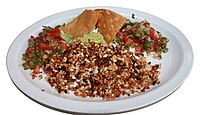Escamol
Edible larvae and pupae of ants
You can help expand this article with text translated from the corresponding article in Spanish. (January 2021) Click [show] for important translation instructions.
- View a machine-translated version of the Spanish article.
- Machine translation, like DeepL or Google Translate, is a useful starting point for translations, but translators must revise errors as necessary and confirm that the translation is accurate, rather than simply copy-pasting machine-translated text into the English Wikipedia.
- Do not translate text that appears unreliable or low-quality. If possible, verify the text with references provided in the foreign-language article.
- You must provide copyright attribution in the edit summary accompanying your translation by providing an interlanguage link to the source of your translation. A model attribution edit summary is
Content in this edit is translated from the existing Spanish Wikipedia article at [[:es:Escamol]]; see its history for attribution. - You may also add the template
{{Translated|es|Escamol}}to the talk page. - For more guidance, see Wikipedia:Translation.
-
 Media: Escamol
Media: Escamol
Escamoles (Spanish: [eskaˈmoles] ⓘ; Nahuatl languages: azcamolli,[1] from azcatl 'ant' and molli 'puree'[2]), known colloquially as Mexican caviar or insect caviar, are the edible larvae and pupae of ants of the species Liometopum apiculatum and L. occidentale var. luctuosum.[3] They are most commonly consumed in Mexico City and surrounding areas.[4] Escamoles have been consumed in Mexico since the age of the Aztecs.[5][6] The taste is described as buttery and nutty, with a texture akin to that of cottage cheese.[7]
-

-
 Escamoles al mojo de ajo
Escamoles al mojo de ajo
See also
- Ant eggs -the eggs and pupae of weaver ants (Oecophylla smaragdina), eaten in several countries across Southeast Asia
- Chahuis — the edible beetles of Mexico
- Entomophagy in humans — the human consumption of insects as food
- List of delicacies
References
- ^ Reyes Castillo; Pedro Montes de Oca; Enrique Montes de Oca (1997). "Fauna". In Enrique Florescano (ed.). El patrimonio nacional de Mexico (in Spanish). Vol. I. Fondo De Cultura Economica USA. pp. 179–180. ISBN 978-968-16-5452-8.
- ^ Émile Bergier (1953). Peuples entomophages et insectes comestibles: Étude sur les moeurs de l'homme et de l'insecte (in French). N. Boubée. p. 152.
- ^ DeFoliart, Gene R. (2009). "Insects as food". In Vincent H. Resh; Ring T. Cardé (eds.). Encyclopedia of Insects. Academic Press. p. 381. ISBN 978-0-08-092090-0.
- ^ Gaso, M.I.; et al. (2003). "Biological monitoring of radioactivity and metal pollution in edible eggs of Liometopum apiculatum (ants) from a radioactive waste site in central Mexico". In Peter Warwick (ed.). Environmental Radiochemical Analysis II. Royal Society of Chemistry. pp. 334–335. ISBN 978-0-85404-618-8.
- ^ Anthony DePalma (2001). Here: A Biography of the New American Continent. PublicAffairs. p. 268. ISBN 978-1-891620-83-6.
- ^ Ramos-Elorduy, Julieta; Moreno, José Manuel Pino (2003). "El consumo de insectos entre los aztecas". In Janet Long (ed.). Conquista y comida: consecuencias del encuentro de dos mundos (in Spanish). Universidad Nacional Autónoma de México. pp. 89–90, 94. ISBN 978-970-32-0852-4.
- ^ Cox, Lauren (May 4, 2010). "Top 5 Disgusting Delicacies". ABC News. Retrieved August 19, 2014.
External links
- Club 700 Hoy video on the harvest of escamoles (in Spanish)
- Julieta Ramos-Elorduy (1998). Creepy Crawly Cuisine: The Gourmet Guide to Edible Insects. Inner Traditions – Bear & Company. pp. 105–110. ISBN 978-0-89281-747-4. (Several recipes for escamoles.)
- v
- t
- e
and stews












- Arroz a la tumbada
- Arroz blanco
- Arroz negro
- Arroz poblano
- Arroz rojo
- Morisqueta
dishes
| Poultry |
|
|---|---|
| Pork | |
| Beef | |
| Seafood | |
protein dishes
- Chahuis
- Chapulines
- Escamoles
- Huitlacoche
- Jumiles
- Maguey worm
| Corn dough |
|
|---|---|
| Wheat dough | |
condiments
and sweets
| Regional | |
|---|---|
| Fusion and diaspora | |
| Historical |
 Food portal
Food portal Mexico portal
Mexico portal Category
Category Commons
Commons Cookbook
Cookbook WikiProject
WikiProject
 | This Mexican cuisine–related article is a stub. You can help Wikipedia by expanding it. |
- v
- t
- e
This ant-related article is a stub. You can help Wikipedia by expanding it. |
- v
- t
- e


















